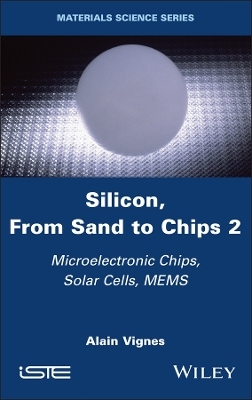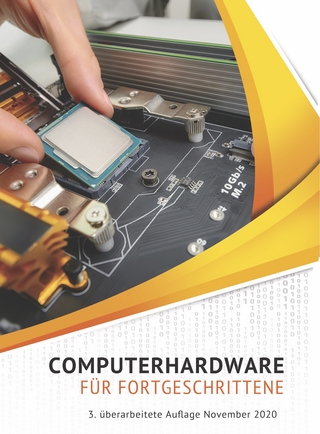
Silicon, From Sand to Chips, Volume 2
ISTE Ltd and John Wiley & Sons Inc (Verlag)
9781786309228 (ISBN)
The discovery of the electronic and optoelectronic properties of germanium and silicon during the Second World War, followed by the invention of the transistor, ushered in the digital age. Although the first transistors were made from germanium, silicon eventually became the preferred material for these technologies.
Silicon, From Sand to Chips 2 traces the history of the discoveries, inventions and developments in basic components and chips that these two materials enabled one after the other. The book is divided into two volumes and this second volume is devoted to microelectronic and optoelectronic chips, solar cells and MEMS.
Alain Vignes was Professor at the École des Mines de Nancy, France, Professor and Director of the Centre des Matériaux at the École des Mines de Paris, France, then Professor at the Institut Supérieur des Matériaux et de la Construction Mécanique, France. He has also acted as a scientific advisor to several industrial companies and as an expert witness for the Paris Court of Appeal.
Preface ix
Introduction The Digital Revolution xv
Chapter 1 Integrated Circuits 1
1.1 Integrated circuits: presentation 2
1.1.1 Logic circuits 2
1.1.2 Analog circuits 3
1.2 The invention of the "integrated circuit" 3
1.2.1 Precursors 3
1.2.2 Jack Kilby's invention 5
1.2.3 Robert Noyce's patent 9
1.2.4 Lehovec's invention 13
1.3 Industrial developments 14
1.3.1 Hybrid circuits 14
1.3.2 Logic function integrated circuits 14
1.3.3 Microprocessors 19
1.3.4 Analog circuits 20
1.4 Integrated circuit technologies 25
1.4.1 Integrated circuit design and photomask production 25
1.4.2 The manufacturing process 25
1.4.3 The technologies 26
1.5 References 30
Chapter 2 Memories 35
2.1 Introduction 35
2.2 SRAM memories 36
2.2.1 Cells and their operation 36
2.2.2 History 40
2.2.3 Industrial developments 41
2.3 DRAM memories 43
2.3.1 Intel 1103 cell 43
2.3.2 The one transistor DRAM cell 44
2.4 Storage memories 47
2.4.1 ROM memories 47
2.4.2 EPROM and EEPROM memories 48
2.5 References 54
Chapter 3 Liquid Crystal Displays 57
3.1 The TFT -- A history 57
3.1.1 The Lilienfeld direct field-effect transistor 57
3.1.2 Welker's TFT 58
3.1.3 Bardeen, Brattain and Gibney's research on the direct field effect 58
3.1.4 Weimer's direct field-effect transistor 59
3.2 The amorphous silicon TFT 60
3.3 Liquid crystal displays 63
3.3.1 History 63
3.3.2 Structure and operation of a liquid crystal display 63
3.4 References 66
Chapter 4 Solar Cells 67
4.1 Introduction 68
4.2 Silicon: the material of solar cells 69
4.3 History 71
4.4 Solar radiation and its absorption 75
4.4.1 Solar radiation 75
4.4.2 Absorption of light energy 76
4.4.3 Quantum efficiency 78
4.5 Crystalline silicon solar cells 79
4.5.1 Manufacturing technology 79
4.5.2 Physical basis of operation 79
4.5.3 Characteristic curve 81
4.5.4 Conversion efficiency from solar energy to electricity 84
4.6 Action of metallic impurities on the solar conversion efficiency 85
4.6.1 Lifetimes and diffusion lengths of "electrons": influence of doping The gettering effect 85
4.6.2 Monocrystalline cells 86
4.6.3 Polycrystalline cells 88
4.7 Amorphous silicon solar cells 89
4.8 Solar silicon manufacturing processes 90
4.8.1 Production of polysilicon (Si-EG) in a fluidized-bed reactor 90
4.8.2 Production of columnar polycrystalline ingots 91
4.8.3 Purification of metallurgical silicon by metallurgical processes 93
4.9 References 94
Chapter 5 Digital Photographic Sensors 97
5.1 Introduction 98
5.2 CCD sensors 98
5.2.1 Features 98
5.2.2 CCD pixel structure and quantum efficiency 99
5.2.3 CCD cell structure and charge transfer 102
5.2.4 Reading circuit 103
5.3 CMOS-APS sensors with active pixels 104
5.4 History 105
5.5 References 108
Chapter 6 Microelectromechanical Systems 111
6.1 Parts for precision mechanics 112
6.2 MEMS: sensors and actuators 113
6.2.1 Presentation 113
6.2.2 History 115
6.2.3 Silicon: the material of MEMS 116
6.3 The physical basis of MEMS operation 118
6.3.1 Sensors 118
6.3.2 Actuators 122
6.3.3 Microelectromechanical resonators 124
6.4 Some examples of MEMS 126
6.4.1 Piezoresistive pressure sensor 126
6.4.2 Gravimetric resonant sensor with vibrating beam 127
6.4.3 Microphone: capacitive sensor 127
6.4.4 Inertial MEMS: accelerometers and gyroscopes 128
6.4.5 Micromotors 132
6.5 MEMS manufacturing technologies 134
6.5.1 Bulk micromachining 134
6.5.2 Surface micromachining 137
6.5.3 Manufacturing processing sequence of a lateral resonant structure 137
6.6 References 139
Index of Names 143
Index of Terms 145
Summary of Volume 1 149
| Erscheinungsdatum | 23.08.2024 |
|---|---|
| Verlagsort | London |
| Sprache | englisch |
| Gewicht | 553 g |
| Themenwelt | Informatik ► Weitere Themen ► Hardware |
| Technik ► Elektrotechnik / Energietechnik | |
| Technik ► Maschinenbau | |
| ISBN-13 | 9781786309228 / 9781786309228 |
| Zustand | Neuware |
| Informationen gemäß Produktsicherheitsverordnung (GPSR) | |
| Haben Sie eine Frage zum Produkt? |
aus dem Bereich


